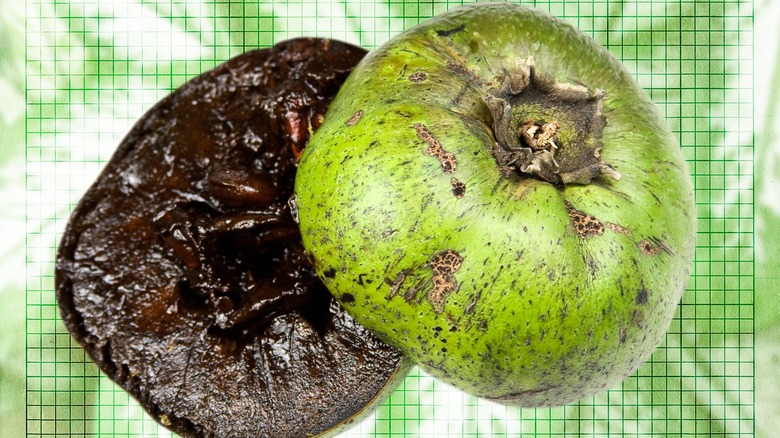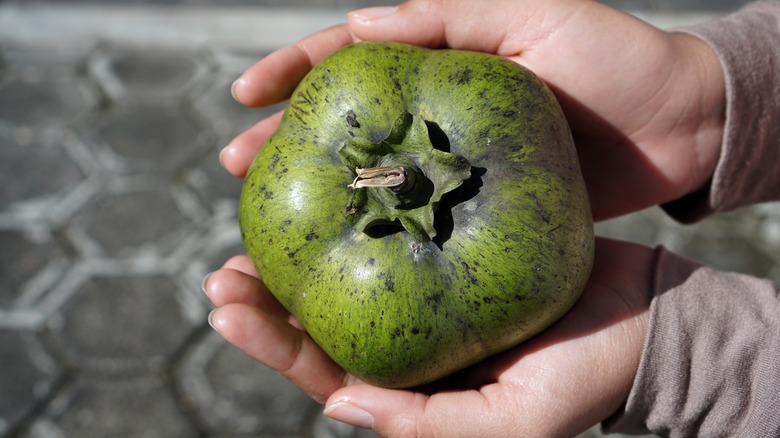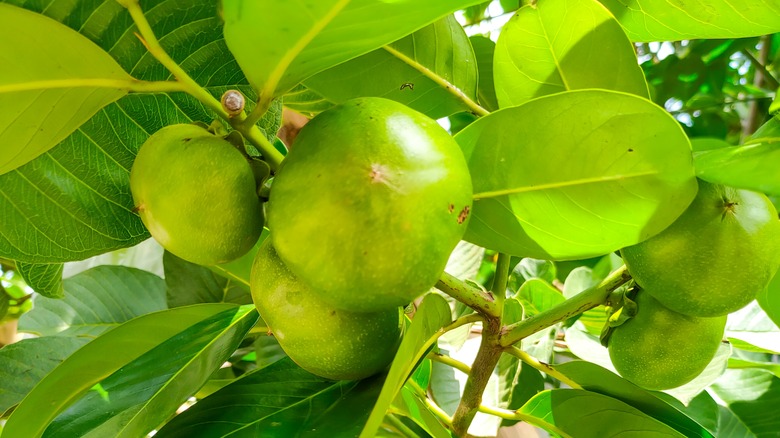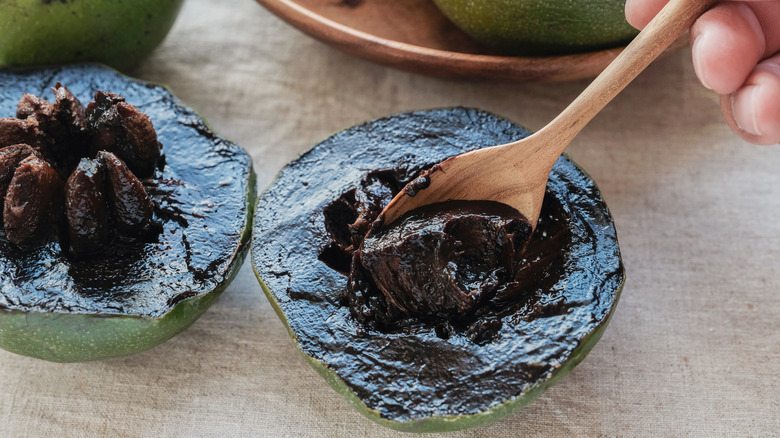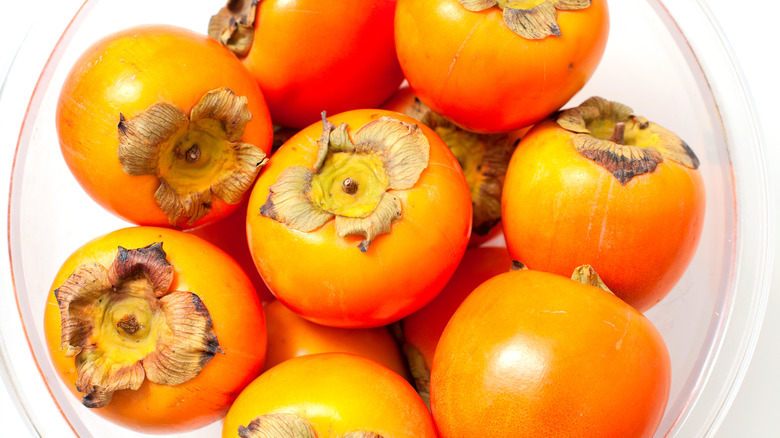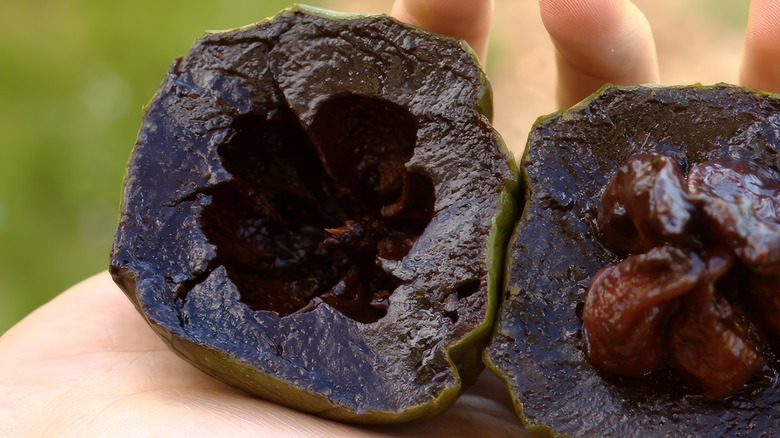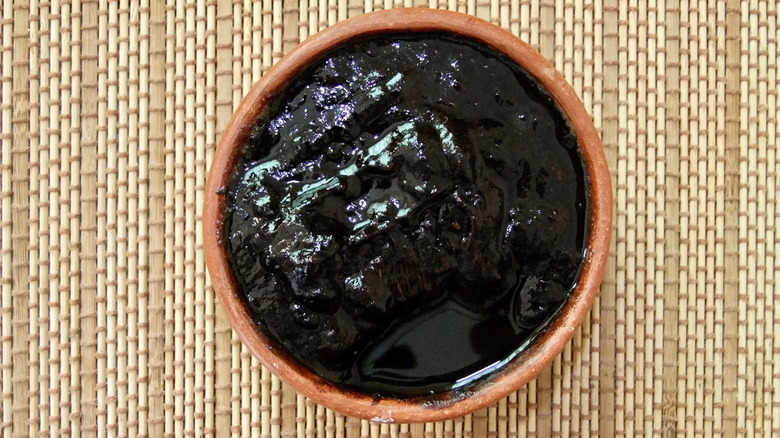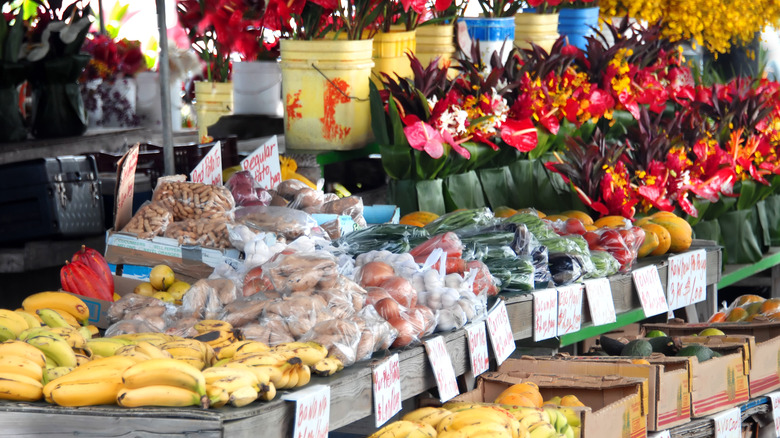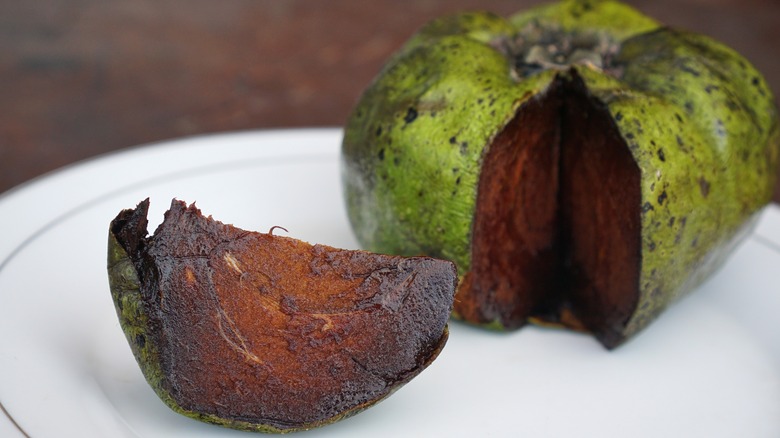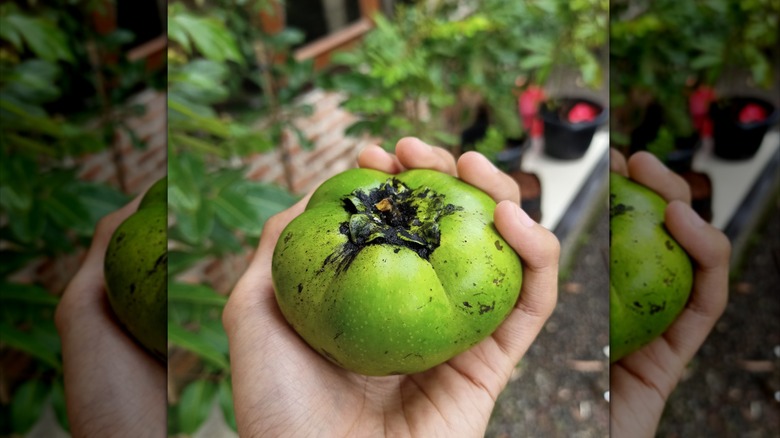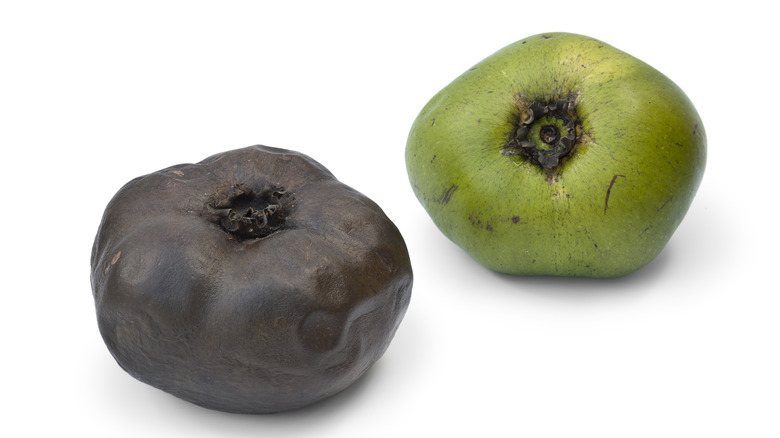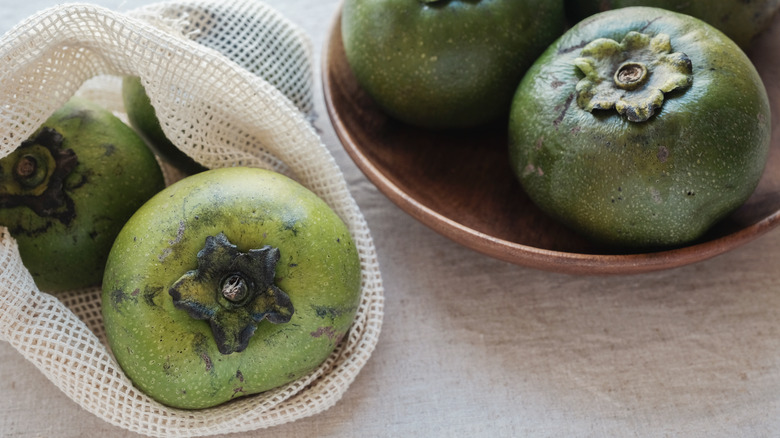Black Sapote: The Unusual Fruit That Resembles Chocolate Pudding
The black sapote (Diospyros nigra), a highly nutritious and very low-calorie fruit, is one of nature's most curious foods. However, not many people in the U.S. and Europe have heard of it, partly because it grows in very few places worldwide and hasn't caught on in regions outside of its natural range.
This fruit, which may have originated in Mexico and other parts of Central America, is known as chocolate pudding fruit because of the color and texture of the fruit's interior when ripe. You can actually scoop out the insides of a ripe black sapote easily with a spoon, and many locals in places where the fruit grows love eating it as a sweet treat.
However, black sapotes are also incredibly delicate fruits that can only be picked, bought, and eaten at specific times. An unripe black sapote is incredibly bitter and hard, with an absolutely terrible taste. So how will you know when you can eat the black sapotes you have at home? And where can you actually find black sapotes in the first place? We're here to answer all the questions you may have about how to pick, store, eat, and cook with black sapotes, as well as what flavors and nutritional values you can expect from this intriguing fruit.
What is black sapote?
Black sapote is a tropical fruit with green skin and white flesh. It ranges anywhere from 2 to 6 inches in diameter. The fruit's skin gets dark speckles as it ripens, and the interior becomes dark brown. The fruit is sometimes seedless, but other times, you will find that a black sapote has five or six large, inedible seeds grouped together in the center.
Despite its name, the black sapote is actually closely related to persimmons rather than other sapotes. The size and shape of the fruit are similar to a regular persimmon, though its coloring is vastly different than the persimmon's signature orange skin. Black sapote trees can grow with male flowers and female flowers on separate trees. But, only the female flower-bearing trees produce fruit. In some cases, you will find male and female flowers on the same tree.
The most unusual and unique part of the black sapote is the consistency of its interior. When properly ripened, the pulp has a custardy texture. This particular fruit texture is rarely replicated in other temperature plants, which makes the black sapote an intriguing oddity for those who grew up outside of tropical regions.
Where does black sapote grow?
Black sapote is native to Central America and has been grown in tropical Mexican regions since Aztec times. The Mayans and Aztecs were actually the first people to spread the popularity of the fruit throughout the region. Black sapote trees are now planted in several other countries throughout the world. However, since this plant can only grow in a specific tropical climate, the black sapote tree is still only found in a limited number of places. These include Indonesia, the Philippines, Puerto Rico, Hawaii, and Southern Florida.
The trees on which these fruits grow have black bark and shiny green leaves. They're hard to miss, as black sapote trees tend to grow quite tall. Medium-sized trees can grow up to a height of 25 to 30 feet, while large trees can extend up to 80 feet.
Though the average time from planting the tree to reaching maturity and producing edible black sapote fruits varies, partly depending on climate and care, it can happen as quickly as three to four years. In other circumstances, it can take five to six years to produce fruit. It's best to plant the trees in full sun to achieve their maximum height potential.
What does black sapote taste like?
Connoisseurs of the fruit can spend hours debating what black sapote fruits actually taste like and end up disagreeing. Almost everyone seems to have a slightly different interpretation and take on this fruit's flavor. But despite its popular nickname of "chocolate pudding fruit," most people who taste a black sapote without knowing much about it or having any set expectations will describe its profile as similar to honey or molasses.
Some still say that the taste of black sapote is reminiscent of chocolate. However, this might just be a subconscious connection being made to the name or the color rather than the distinguishable flavor in the fruit. The range of flavor profiles of the black sapote includes soft notes of honey, dates, caramel, and even molasses. Overall, black sapote is on the sweet side, though not overwhelmingly so. That is, assuming that the fruit has fully ripened. If not, it has an incredibly bitter taste that will make your mouth pucker.
Black sapote vs. persimmon
The black sapote is not a "true" sapote but rather closely related to the persimmon family. The name sapote refers to any soft, edible fruits or plants of the Sapodilla family that bear edible fruits. The black sapote is part of the Ebenaceae family instead — not Sapodilla. The black sapote is similar to other Sapodilla fruits in that it has a shared origin in Mexico and Central America.
Persimmons look different from black sapotes at first glance, as they have orange-red skin instead of the black sapote's traditionally green one. Most of the persimmons we purchase from the grocery store originate in Asia, with the two most popular varieties being Fuyu and Hachiya. Though there is an American persimmon, you will not often find it while out and about shopping.
Despite their differing place of origin, persimmons are also part of the Ebenaceae family. Lastly, the trees that bear persimmon fruit are somewhat similar to black sapote trees in that they grow about 20 to 30 feet tall and have glossy, dark green leaves. Both persimmons and black sapote are dioecious — meaning that there are instances of the male plants growing on separate trees than the fruit-bearing female plants. Like the black sapote, you'll also have to express care when picking persimmons because the fruit has a short harvest timeline.
How and when to eat black sapote
Knowing when to eat a black sapote is the key to having a delicious experience with the fruit. Before a black sapote ripens, it is borderline inedible since it has a rock-hard texture and bitter taste. When the fruit looks almost spoiled, with brown speckles on the outside and a dark brown interior that has an easily scoopable consistency, it's ready to eat.
The brown interior may be hard for some first-time eaters to overcome, as most people associate the brown color of a fruit as a sign of rotting. However, you would never confuse rotten black sapote for ripe black sapote, as the former is given away by a pungent, awful odor, as well as a slimy texture. No matter what stage a black sapote is in, the skin is generally not eaten.
Black sapotes are in season during the winter months, though this can vary depending on where they're grown. Availability can start either a bit earlier (late summer) or end later (through the spring). When the fruit is ready to eat, just cut it open, put a spoon in it, and scoop out the brown, soft flesh on the inside. Or, you can use the fruit to make a variety of recipes.
How to cook with black sapote
Though you can eat this tropical fruit by itself, you can also make recipes like black sapote pudding and fruit smoothies. Thanks to the fruit's sweet flavors, it is generally used as a base for dessert and dessert-like dishes, though you can also bake it into bread. It can also be used as mousse, pie filling, and as a flavoring in ice cream.
Only ripe sapotes should be used in any recipe. In order to cook with black sapote, you first have to remove the large seeds in the center of the fruit (if there are any) and the thin membrane surrounding them. Then, you will likely have to scoop out as much pulp as possible.
A lot of the mousse and pudding recipes are pretty straightforward. They essentially involve putting the black sapote pulp, as well as other ingredients you have to use, such as sugar, vanilla extract, or coconut milk, together and mixing them all with an electric mixer or food processor. More complicated recipes, such as ice cream or baked recipes, require several extra steps. However, if you know how to make homemade ice cream, substituting black sapote for the usual flavoring ingredient of choice shouldn't be too much of a problem. The same goes for black sapote bread, which is essentially a take on banana bread with black sapote instead of the other tropical fruit.
Where to buy black sapote
Because it can only be grown in the tropics, black sapote is generally sold in farmer's markets in Central America, Mexico, Australia, and tropical areas of Asia. The popularity of this fruit hasn't caught on worldwide, though. There are many reasons for this, including a lack of specific guidance on when and how to use the fruit. Plus, the fruit has a short window in which it is edible, which means black sapotes are rarely found far from the places in which they are planted, as many fruits would go bad in transport or generally be unable to withstand the process of overseas shipping.
If you live in the United States, for the most part, you won't be able to pick up a black sapote in your local supermarket. However, if you live in regions where the fruit is grown, including southern Florida, Hawaii, or the island of Puerto Rico, you can probably find black sapotes at local farmers' markets.
Is the black sapote nutritious?
One of the many upsides of black sapotes is that they have an exceptional nutritional profile, which cannot be said for many sweet foods. So, if you're going to use something to make a treat like ice cream or mousse, you might as well make it the highly nutritious and delicious black sapote.
This fruit contains high amounts of vitamin C, vitamin A, calcium, fiber, iron, phosphorus, and potassium, along with smaller trace amounts of many other minerals and vitamins. Its vitamin C levels are particularly high; 100 grams of the fruit contains 19 milligrams of vitamin C, which is upwards of 20 to 25% of the daily recommended intake of the micronutrient. Eating this same amount of black sapote provides 39 milligrams of calcium. All these vitamins and minerals help your body function better overall, grow stronger bones, and bolster your immune system function.
When to pick black sapote from trees
Knowing when to pick black sapote from a tree is a delicate art, as one wrong move can render the fruit inedible by the time you get it on your counter back home. Black sapotes can't be picked from trees too early; otherwise, they will fail to ripen and simply rot. However, they often can't be left to ripen on the tree either, as birds and other insects will likely pick on the sweet fruits before you can get to them.
You will know a black sapote is ready to be picked when the stem has lifted from the base of the fruit. It will usually also have tiny black markings on its skin, indicating that it has already started the ripening process. Once it has been picked, keep it on your counter. You can expect it to ripen fully and be ready to eat after between two and 10 days.
When to buy black sapote
You should always buy black sapotes in their unripened form, as indicated by an olive green, unspeckled exterior. The dark brown color will develop as the fruit reaches ripeness. Avoid any black sapotes with broken skin.
Most black sapotes are sold underripe because they are incredibly delicate when in their ripe form. Also, when a black sapote is already ripe, there is a limited window in which it can be eaten. Selling ripe black sapotes would just result in a lot of food waste, as many of them would go bad before being purchased or leave the customer with a very short time in which to eat their newly acquired fruit.
Lastly, black sapotes are usually only sold in-season, which covers winter and the very early spring for the most part. You're unlikely to find black sapotes anywhere if you shop for them outside this seasonal window.
How to store black sapote
The good news about this otherwise delicate fruit is that storage is relatively straightforward. Leave the fruit on the counter or in a fruit bowl at room temperature while waiting for it to ripen. These ambient conditions will enable the ripening process. Do not store the fruit in the fridge unless it's already ripe and soft to the touch. If you notice your black sapote is ripe but you're not ready to eat it yet, put it in the fridge, where it will last in its ripe phase for three to five days.
After you cut into a black sapote, it will dry out pretty fast, so you generally want to make sure you're eating the entire pulp or using all of it in a recipe. Otherwise, it will lose the easily spoonable texture that makes it such a unique fruit and joy to consume.
Other varieties of sapote
White sapotes, the only other fruits that bear the sapote name yet aren't "true" sapotes, are more closely related to the citrus family. The white sapotes also have an aptly named white, custard-like interior. Other sapotes come from the Sapotaceae family and include sapodilla, yellow sapote, mamey sapote, and green sapote. All are native to various parts of Mexico and Central America.
The sapodilla's skin is textured and brown, with the fig-like interior of the fruit described as having a taste of brown sugar and pears. Mamey sapotes have similar skins to the sapodilla, but their insides are deep, vibrant orange in color and taste somewhat like almonds.
Yellow sapotes are more commonly known as canistels. The fruit has a yellow-orange skin and its interior, as the name implies. Canistels have a sweet flavor with notes of eggnog, which is perhaps why yet another name for this plant is eggfruit. Lastly, green sapotes have green-yellow skin and orange-red pulp. The fruits aren't well-known outside Central America, though many people who eat them believe their flavor is stronger and better than the closely related mamey sapotes.
